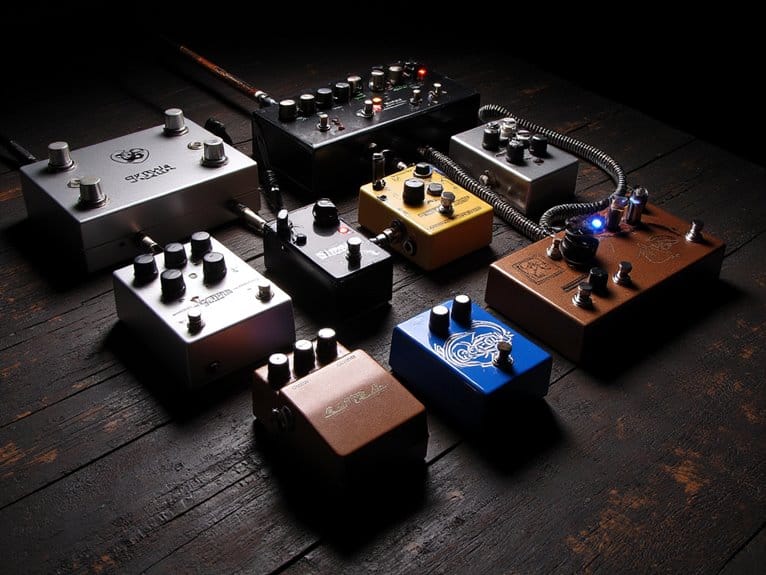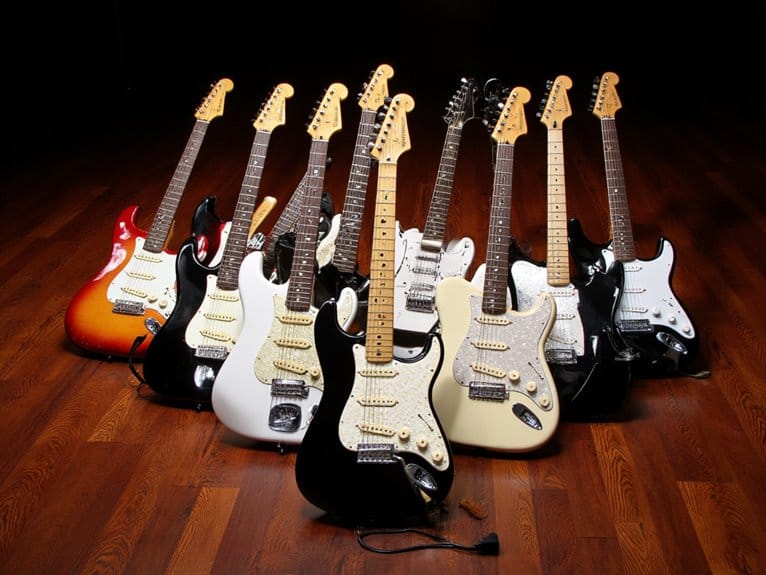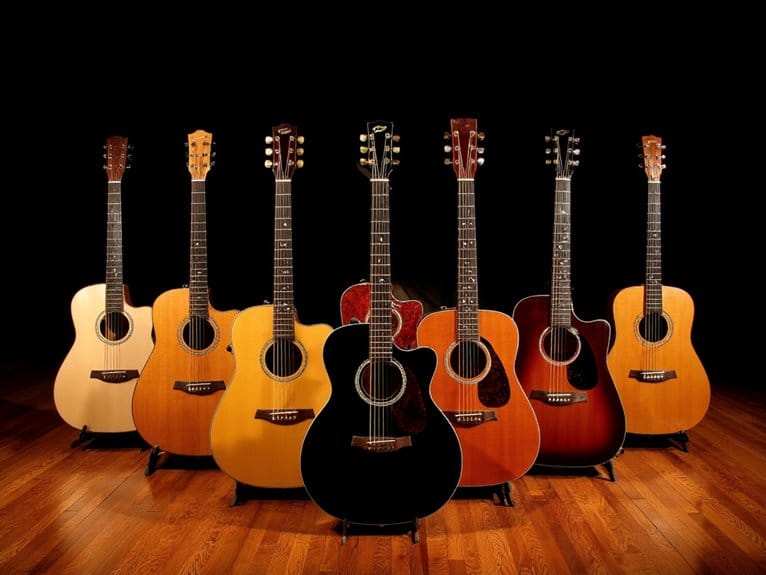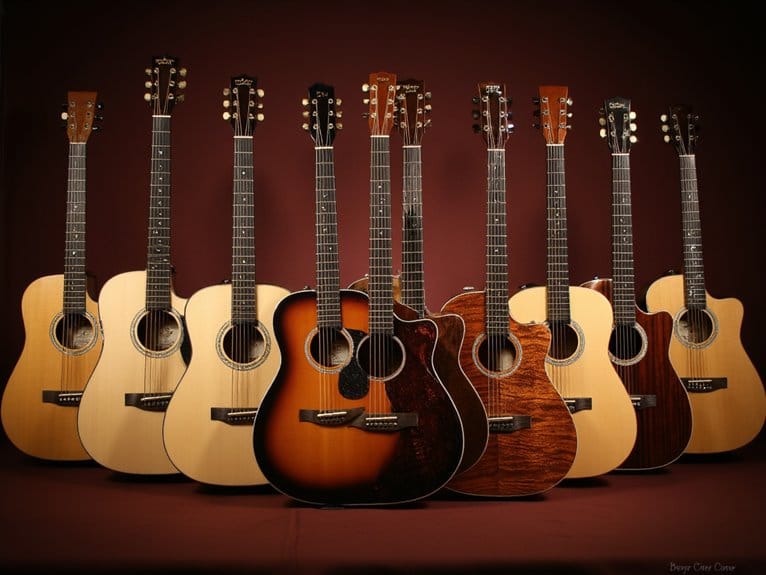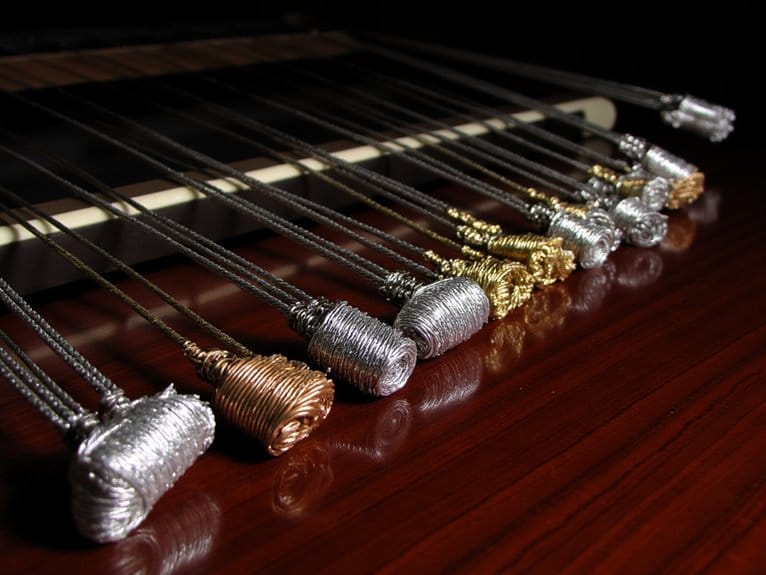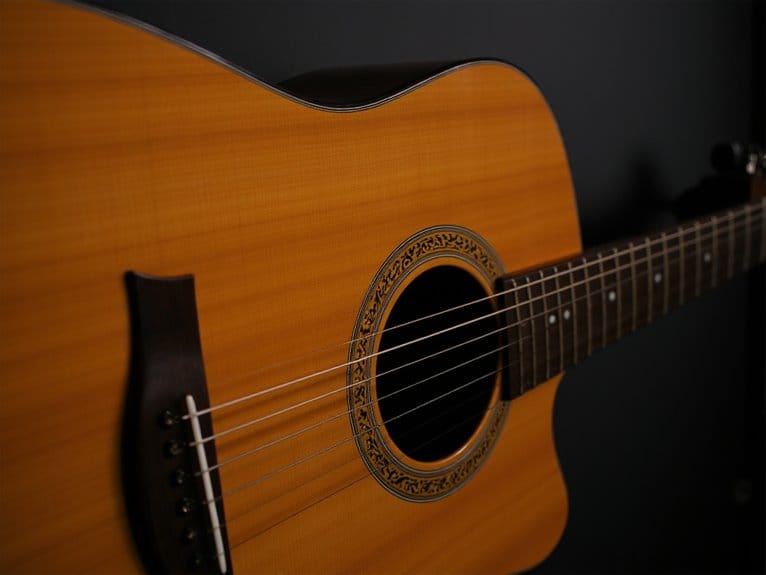Best Loop Pedals for Guitar That Will Transform Your Sound
After testing dozens of loop pedals, I’ve found that models like the LEKATO Guitar Looper with its 9 loops and 40-minute capacity, alongside the Donner Triple Looper‘s impressive 90-minute recording time, offer exceptional value for transforming your sound. The Boss RC-1 remains my go-to for reliability, while LEKATO’s built-in tuner feature eliminates setup hassles during live performances. Each pedal serves different needs, from bedroom practice to professional gigging, and understanding their specific strengths will help you choose the perfect match for your musical goals.
We are supported by our audience. When you purchase through links on our site, we may earn an affiliate commission, at no extra cost for you. Learn more.
Notable Insights
- Loop pedals enable guitarists to layer multiple recordings live, creating complex arrangements and transforming solo performances into full compositions.
- Recording time varies from 2-10 minutes on basic models to 90+ minutes on advanced units like the Donner Triple Looper.
- High-quality models feature 48KHz sampling rates and 24-bit processing for professional sound clarity and lossless audio recording capabilities.
- Budget-friendly options like LEKATO pedals offer excellent value with professional features, while Boss RC-1 provides superior durability.
- Built-in features such as tuners, auto-save functions, and USB connectivity enhance convenience and streamline the recording workflow process.
Donner Triple Looper Guitar Pedal with 90 mins Looping Time
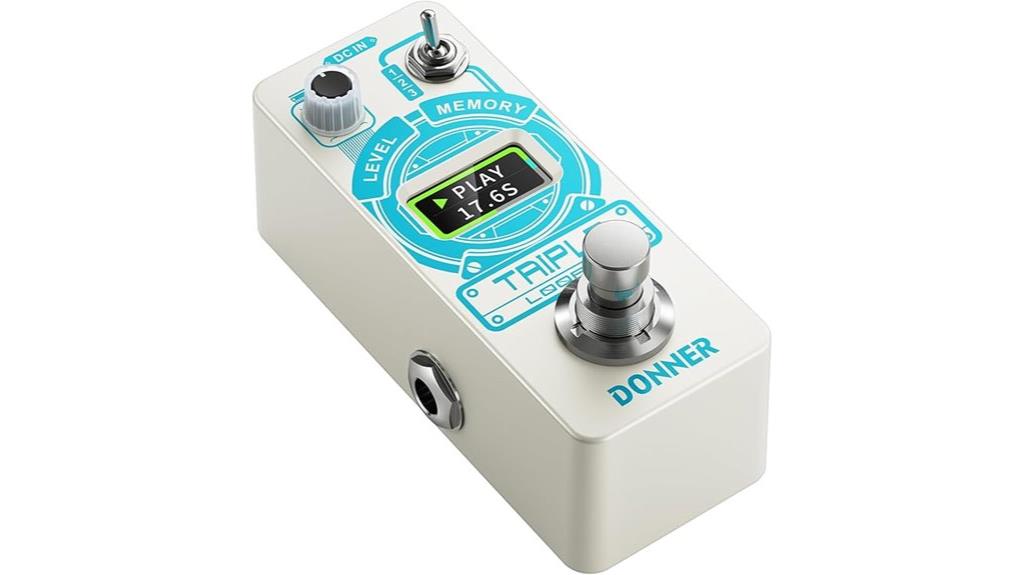
Musicians seeking extended looping capabilities without breaking the bank will find the Donner Triple Looper Guitar Pedal particularly compelling, as it delivers an impressive 90 minutes of total recording time across three separate tracks. Each individual loop accommodates up to 30 minutes of audio, while the bright display keeps you informed about current mode, timing, and progress throughout your performance. You’ll appreciate the single footswitch design that controls all essential functions—record, play, overdub, stop, and clear—making operation surprisingly intuitive during live situations. The pedal’s powerful internal chip automatically saves your work when powered down, though you’ll need to purchase a separate 9V DC adapter.
Best For: Musicians who need extended looping time for live performances, practice sessions, or creative composition work and want an affordable pedal with multiple track capabilities. These musicians will appreciate the versatility of the pedal, which allows for seamless layering and intricate soundscapes. Additionally, the inclusion of expression pedals for realtime control enhances the performance, enabling dynamic changes to effects and volume levels on the fly. This feature makes it an invaluable tool for both seasoned performers and those looking to experiment with new sounds.
Pros:
- Generous 90 minutes of total looping time across three separate 30-minute tracks
- Bright display shows current mode, timing, and progress for easy monitoring during performance
- Automatic saving feature preserves recorded loops even when powered off
Cons:
- Power adapter sold separately, requiring additional purchase for operation
- Single footswitch design may be limiting for complex live performance scenarios
- Limited to only three loop tracks compared to some higher-end loopers
Boss RC-1 Loop Station
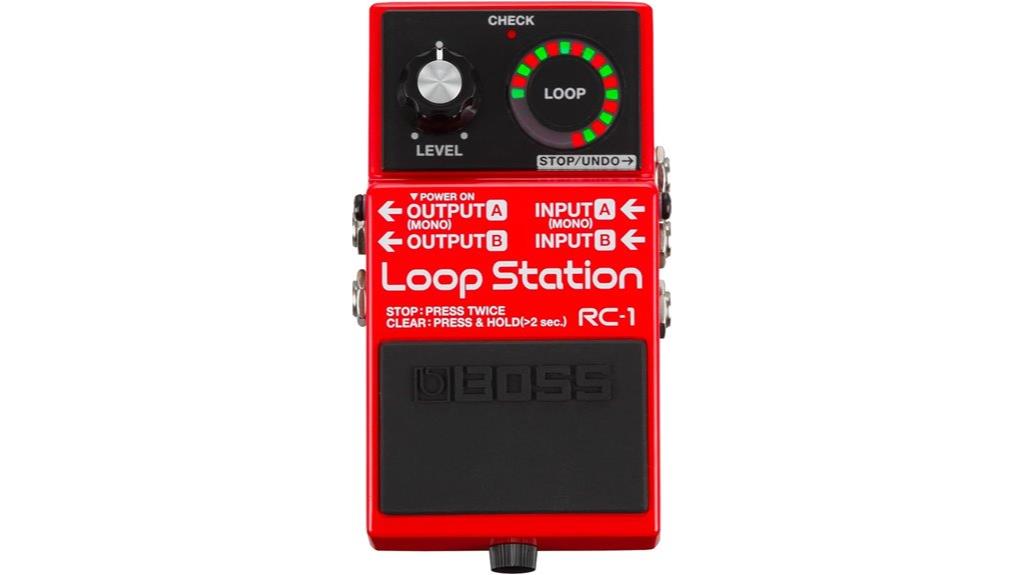
Simplicity defines the Boss RC-1 Loop Station’s appeal, making it the ideal choice for guitarists who want professional looping capabilities without wrestling with complicated menus or overwhelming features. You’ll appreciate the straightforward operation that delivers 12 minutes of stereo recording time, basic overdub functions, and reliable undo/redo capabilities through a single footswitch design. The multicolored LED circle provides clear visual feedback about your loop status, while the compact 5.08 x 2.32 x 2.87-inch footprint won’t crowd your pedalboard setup. At 4.6 stars from over 3,500 reviews, this pedal consistently outperforms cheaper alternatives in durability and sound quality, though you won’t find advanced features like multiple tracks or built-in tuning capabilities.
Best For: Guitarists and musicians who want reliable, professional-quality looping capabilities with simple operation for songwriting and live performance without complex features.
Pros:
- Simple, intuitive single-footswitch design with clear multicolored LED status indicator makes it beginner-friendly and quick to learn
- Delivers 12 minutes of high-quality stereo recording with reliable overdub and undo/redo functionality in a compact pedalboard-friendly size
- Proven durability and superior sound quality compared to cheaper alternatives, backed by 4.6-star rating from over 3,500 reviews
Cons:
- Lacks advanced features like multiple track recording capabilities that some users desire
- No built-in tuner functionality, requiring a separate tuning solution
- Single AAA battery power requirement may be inconvenient for extended use
LEKATO Guitar Looper Pedal with Tuner Function (9 Loops, 40 minutes Record Time)
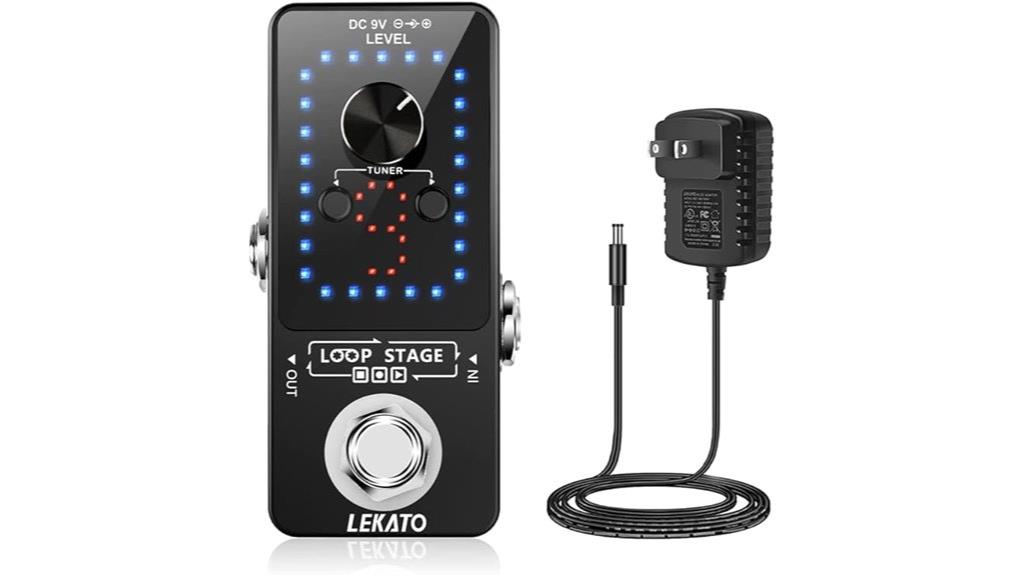
Budget-conscious guitarists seeking professional looping capabilities will find the LEKATO Guitar Looper Pedal delivers impressive functionality that typically costs twice as much from competitors. You’ll get nine individual loops with up to 10 minutes each, totaling 40 minutes of recording time, plus a built-in tuner that users consistently praise for accuracy. The 48K/24bit sampling rate guarantees professional audio quality without unwanted noise, while unlimited overdubbing lets you layer tracks seamlessly. Though the single-switch design requires practice to master, you’ll appreciate the USB interface for importing and exporting wav files to your computer for further editing.
Best For: Budget-conscious guitarists and musicians who want extensive looping capabilities with professional audio quality without spending twice as much on competitor products.
Pros:
- Nine individual loops with 40 minutes total recording time and unlimited overdubbing at professional 48K/24bit sampling rate
- Built-in accurate tuner and USB interface for easy import/export of wav files to computer
- Excellent value offering twice the loops of popular competitors like Boss RC1 at half the typical price
Cons:
- Single-switch design makes it challenging to stop loops while continuing to play and requires practice to master
- Instructions are unclear and not intuitive for beginners, requiring patience during initial setup
- Power adapter not included despite being necessary for convenient operation
LEKATO Guitar Looper Effect Pedal (5 Minutes Looping Time)
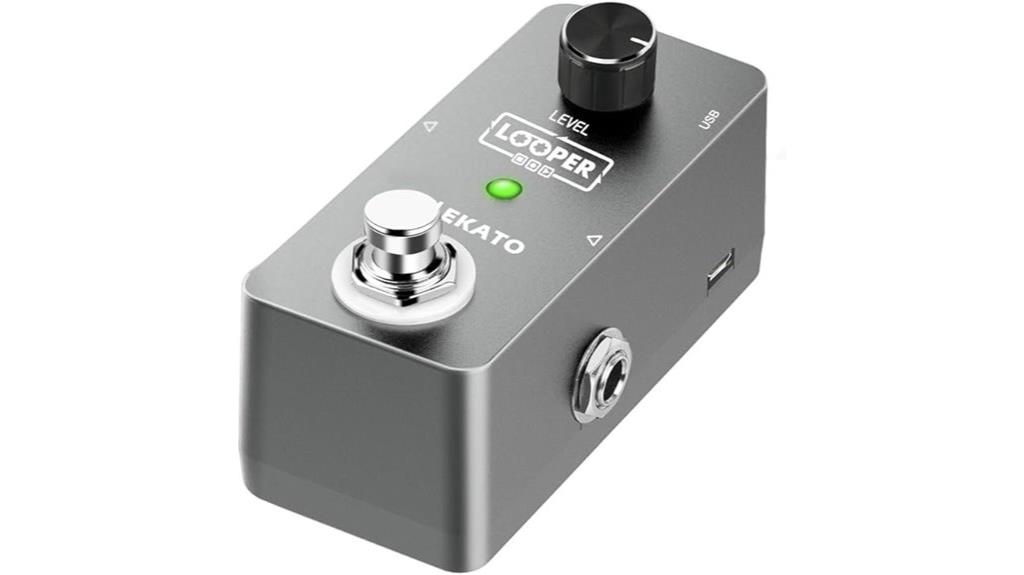
Compact dimensions of just 1.95 x 1.57 x 1.95 inches make the LEKATO Guitar Looper Effect Pedal an ideal choice for guitarists who prioritize portability without sacrificing essential looping functionality. You’ll get five minutes of looping time with unlimited overdubs, plus 24-bit uncompressed audio quality that maintains professional standards. The single-knob operation keeps things delightfully simple, though you might struggle with the double-tap commands initially. While rapid battery drainage becomes problematic during extended sessions, requiring a 9-volt adapter purchase, the analog-dry-through design preserves your original tone integrity. At under fifty dollars, this pedal delivers solid value for beginners seeking straightforward looping without overwhelming complexity.
Best For: Beginner guitarists and practicing musicians who need a compact, affordable looping pedal with straightforward operation for experimentation and practice sessions.
Pros:
- Extremely portable at just 1.95 x 1.57 x 1.95 inches with 5 minutes of looping time and unlimited overdubs
- High-quality 24-bit uncompressed audio with analog-dry-through design that preserves original tone integrity
- Simple single-knob operation and excellent value under $50 for entry-level looping needs
Cons:
- Rapid battery drainage requires purchasing a separate 9-volt power adapter for extended use
- Double-tap commands for stopping loops can be difficult to master and may cause timing issues
- Limited to essential looping features only, lacking advanced functionality for more experienced users
Factors to Consider When Choosing Loop Pedals for Guitar
When I’m helping guitarists choose their ideal loop pedal, I’ve found that five critical specifications consistently determine whether a unit will meet their creative needs or leave them frustrated during performances. Recording time capacity affects how long your loops can run before cutting off, while the number of available loops determines whether you can layer simple chord progressions or build complex, multi-part compositions with distinct sections. Audio quality specifications, power requirements, and built-in tuner functionality round out the essential features that separate professional-grade units from basic practice tools, though each factor carries different weight depending on your specific playing style and performance demands.
Recording Time Capacity
Recording time capacity stands as perhaps the most fundamental specification I evaluate when selecting a loop pedal, as it directly determines how much musical content you can capture and layer before hitting the device’s memory limitations. I’ve found that basic models typically offer anywhere from two to ten minutes total, while professional units can provide several hours of recording time across multiple tracks. The key consideration isn’t just total capacity, but how it’s distributed—some pedals allow up to ten minutes per individual loop, which I consider essential for extended performances or complex layering scenarios. I always assess both per-loop maximums and cumulative recording time, since having quick access to multiple recorded loops during live performances makes the difference between seamless shifts and awkward pauses.
Number of Loops
Beyond storage capacity, the number of individual loops a pedal supports fundamentally shapes your creative possibilities, determining whether you’ll craft simple rhythm-and-lead combinations or complex, multi-layered compositions that rival full band arrangements. I’ve found that single-loop pedals work brilliantly for straightforward backing tracks, while multi-loop models, typically offering 1 to 9 loops, enhance exponentially greater versatility for intricate soundscapes. When I’m switching between loops during performances, having multiple concurrent options allows seamless shifts between verse, chorus, and bridge sections without stopping the music. However, more loops inevitably mean more complexity in management and operation, so I’d recommend starting with fewer loops if you’re new to looping, then upgrading as your skills and creative ambitions expand beyond basic layering techniques.
Audio Quality Specifications
Three critical audio specifications determine whether your loops will sound crisp and professional or suffer from noticeable degradation that undermines your performance quality. I always check the sampling rate first, looking for 48KHz or higher, which captures those subtle harmonics and overtones that make your guitar sound authentic rather than digitized. The bit-depth matters equally—24-bit processing guarantees your loops maintain their dynamic range, preventing that compressed, lifeless sound I’ve heard from cheaper units. I particularly value lossless, uncompressed audio formats that preserve every nuance of your original performance. Professional loopers also include Analog-Dry-Through features, allowing your clean signal to bypass digital processing entirely while effects enhance your loops, plus advanced noise reduction that keeps multiple overdubs sounding clean.
Power Requirements
While pristine audio quality sets the foundation for professional-sounding loops, I’ve learned that power requirements can make or break your performance setup, especially when you’re halfway through a gig and your pedal suddenly dies. Most loop pedals demand external 9V DC adapters, which manufacturers frustratingly don’t always include, leaving you scrambling for compatible power sources. I’ve discovered that checking center-negative versus center-positive connections prevents costly compatibility mishaps, while understanding milliamp ratings guarantees your power supply matches the pedal’s current demands. Battery-operated models offer undeniable portability advantages, though I’ve watched performers struggle with rapid battery drain during extended sessions, making external adapters the reliable choice for serious gigging despite reduced mobility.
Built-in Tuner Function
Since I’ve spent countless hours fumbling with separate tuner pedals during live performances, I can’t overstate how game-changing a built-in tuner function becomes when you’re managing multiple loops and need quick pitch corrections between songs. High-sensitivity tuners integrated within loop pedals guarantee accurate tuning while maintaining pitch consistency across layered loops, which becomes essential when you’re building complex musical arrangements. The visual LED indicators provide real-time feedback that’s visible even in dimly lit venues, something I’ve learned to appreciate after too many squinting episodes on dark stages. Most importantly, these tuners operate silently during tuning mode, allowing seamless shifts without disrupting your musical flow or forcing awkward pauses that can kill the momentum you’ve carefully built.
USB Connectivity Features
Having wrestled with countless backup drives and cloud storage solutions for my musical projects, I’ve discovered that USB connectivity transforms loop pedals from simple performance tools into all-encompassing recording workstations that seamlessly bridge the gap between live creativity and studio production. Most modern units recognize standard WAV files without requiring additional drivers, which eliminates the technical headaches I once endured during late-night recording sessions. I particularly value models that automatically save recordings even when powered off, since I’ve learned the hard way that brilliant ideas vanish quickly. The ability to transfer experiments directly to my PC for archiving, plus firmware updates that continuously enhance functionality, makes USB connectivity an essential feature that extends your pedal’s lifespan considerably.
Pedal Size and Portability
When I’m assembling a pedalboard that needs to travel from venue to venue, I’ve learned that the physical footprint of my loop pedal can make or break my entire setup, especially since cramped stages and tiny backstage areas don’t accommodate bulky gear gracefully. Compact loop pedals typically measure around 4.5 by 2.5 inches, fitting seamlessly between other effects while maintaining full functionality through clear LED indicators and intuitive control layouts. Lightweight designs, often under one pound, dramatically reduce my gear’s total weight during long hauls between gigs. I’ve found that travel-friendly features like robust metal housings and efficient power consumption help these smaller units withstand constant transport abuse. Despite their diminutive size, quality compact loopers retain essential performance capabilities without sacrificing the quick setup times that venue changes demand.
On a final note
I’ve tested dozens of loop pedals over the years, and honestly, you can’t go wrong with most options on this list. The LEKATO models offer exceptional value with their tuner integration and generous recording times, while the Boss RC-1 delivers that legendary reliability I’ve come to expect. Whether you’re layering ambient textures or building complex rhythmic foundations, these pedals will expand your creative possibilities without breaking the bank.

